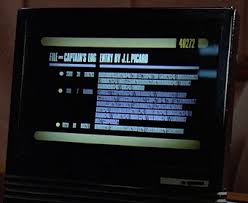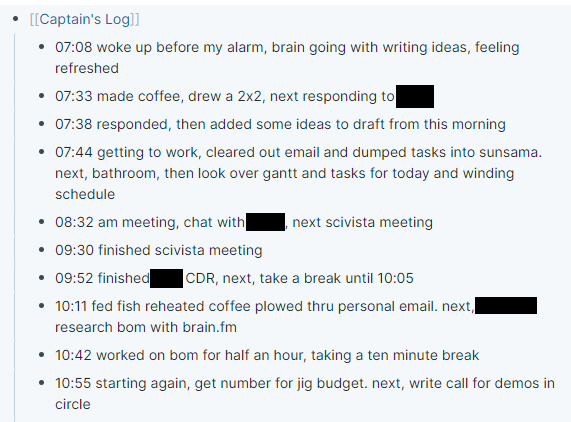Captain's Logs for Navigating Knowledge Work
“Captain’s Log. Stardate 2020 point 8. Today is our 6th day of interstitial journalling, a little under one week into our two week mission…”

Captains of sailboats and spaceships alike keep Captain’s Logs 1.
Even if you hate water or never plan to pilot a spacecraft, you too can keep a Captain’s Log.
The instructions are simple: Write down the time, what happened, and what’s coming next.
A Captain might write in their log to note a major event, or to track their position on the high seas. But you’re a knowledge worker, not a skipper. Instead, write in your Captain’s Log when you change tasks, when you take a break, or when you get distracted. Think of it as a way to track the ‘position’ of your productivity spaceship.
The act of logging helps to keep you on task. And upon review, you might uncover some surprising tidbits about yourself.

Keeping a Captain’s Log for 14 Days
I kept a detailed Captain’s Log for two weeks, documenting my 8-to-5 work day.
The first tasks were easy enough. Mark the time, write down what you did, write down what’s next, do it.
With my Log always open on my screen, it felt easy to stay on task. The act of writing down what’s next forced me to clarify what I’m doing. That clarity helped bring me into flow.

I was surprised at how well this method kept me in the zone. After a few days I had to start scheduling breaks or I’d keep working for too long.
However, I am not a perfect productivity robot. There were times where I wasn’t sure what to do, or when the next step felt a bit too large. Instead of tackling the uncertainty, my brain chose to do something mindless like checking twitter.

Distractions like this could be recovered by getting clear and reducing the scope of the next task. Making the next task as easy as possible got me started, which was usually enough to pull me into flow.
Captain’s Logs and Beating Yourself Up
In mindfulness meditation, you might be asked to focus on the breath. When your mind inevitably wanders to pink elephants, you’re instructed to bring your attention back to the breath.
You could approach this return to the breath in two ways: forcing, or equanimity.
Forcing: “Ah I’m so stupid, I can’t focus for shit, how useless. Ughhh focus focus focus.”
Equanimity: “Ah, that’s funny, I ended up thinking about pink elephants. Let’s go back to the breath.”
Equanimity: mental calmness, composure, and evenness of temper, especially in a difficult situation.
With your Captain’s Log, the first approach could be really painful. Calling yourself out every time you get distracted can feel like an attack. You’ll end up fighting yourself, which is not helpful.
But if you approach your Captain’s log with the second mindset, the mindset of equanimity, each distraction turns from a negative into an opportunity.
In mindfulness meditation, the act of returning your focus to the breath is a chance to practice
Here too, is a chance to practice coming back to the task at hand.
The monk practices returning to the breath. The NBA player practices rebounds. The knowledge worker practices coming back to the task at hand.
Why don’t knowledge workers “watch tapes”?
Speaking of NBA players, professional athletes review tapes of their gameplay, so why don’t knowledge workers do the same? For one, a videotape of you sitting at a desk would be incredibly boring. I also doubt its ability to tell you anything about your work.
However, a Captain’s Log can actually provide useful insight. You get a record of what you were trying to do, and what actually happened.
Looking over my logs from these past 14 days, some patterns start to emerge:
- I’m more likely to get distracted in the liminal moments between tasks, especially right after meetings.
- Distractions occur more often in the early afternoon
- New to me: I get a boost of energy in the early evening, and am really productive during this time.
Reviewing Logs is a great way for the deskbound to ‘review tapes’ and discover insights into the way we work.
Will I keep using a Captain’s Log Everyday?
Yes and no.
Logging puts me into flow astonishingly fast, and keeps me there for a longer portion of the day that I would normally. I learned a lot about my own workstyle by reviewing logs. These past two weeks were very productive.
Despite all of these benefits, I’ve decided I won’t be keeping a Captain’s log everyday. Something about the mind-state it puts me in is unnerving, like I’m strapped to a cart on rails. Even during breaks I get the sense that I need to plug back in to the Log.
I’m reminded of this quote from James Carse:
“To operate a machine one must operate like a machine. Using a machine to do what we cannot do, we find we must do what the machine does.” - Finite and Infinite Games
Maybe it’s good for my work output, but it’s not a mode I want to be operating in all of the time.
Still, the Captain’s Log deserves a place in my Productivity Toolbox. I’ll break it out once a quarter or so.
Use a Captain’s Log when you want to:
- run a time audit
- catch procrastination rabbit holes
- break out of procrastination loops
- get a ton done up against a deadline
- rebuild awareness during your workday
It’s a technique worth trying. Give it a whirl.
“Captain’s Log. Stardate 2020 point 11. Today we complete our mission, having successfully logged our working hours for two full weeks…”
Have you tried keeping a Captain’s Log? Do you use it everyday? Let me know!
Note:
[1] Captain’s Logs are also called interstitial journaling, or temporal journaling.